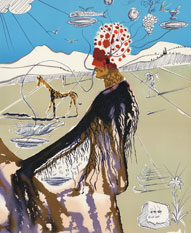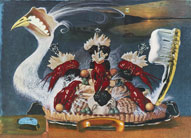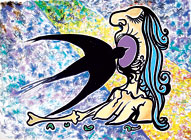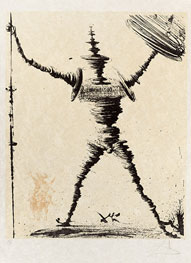

|
|
Salvador Dali 1904-1989. As an art student in Madrid and Barcelona, Dali assimilated a vast oeuvre as a painter. It was not until the late 1920s, however, that two events brought about the development of his mature artistic style: his discovery of Sigmund Freud's writings on the erotic significance of subconscious imagery, and his affiliation with the Paris Surrealists, a group of artists and writers who sought to establish the "greater reality" of man's subconscious over his reason. To bring up images from his subconscious mind, Dali began to induce hallucinatory states in himself by a process he described as "paranoiac critical." Once Dali hit on this method, his painting style matured with extraordinary rapidity, and from 1929 to 1937 he produced the paintings which made him the world’s best-known Surrealist artist. He depicted a dream world in which commonplace objects are juxtaposed, deformed, or otherwise metamorphosed in a bizarre and irrational fashion. Dali portrayed these objects in meticulous, almost painfully realistic detail and usually placed them within bleak, sunlit landscapes that were reminiscent of his Catalonian homeland. Perhaps the most famous of these enigmatic images is "The Persistence of Memory" (1931), in which limp, melting watches rest in an eerily calm landscape. With the Spanish director Luis Boulez, Dali also made two Surrealistic films--Un Chien andalou (1928; An Andalusian Dog) and L'Age d'or (1930; The Golden Age)--that are similarly filled with grotesque but highly suggestive images. In the late 1930s Dali switched to painting in a more academic style under the influence of the Renaissance painter Raphael, and as a consequence he was expelled from the Surrealist movement. Thereafter he spent much of his time designing theatre sets, interiors of fashionable shops, and jewelry, as well as exhibiting his genius for flamboyant self-promotional stunts in the United States, where he lived from 1940 to 1955. In the period from 1950 to 1970 Dali painted many works with religious themes, though he continued to explore erotic subjects, to represent childhood memories, and to use themes centering on his wife, Gala. Notwithstanding their technical accomplishments, these later paintings are not as highly regarded as the artist's earlier works. The most interesting and revealing of Dali's books is The Secret Life of Salvador Dali (1942-44). |
![]()

The Professions: Restaurateur
Colour lithograph on arches
74 x 53.5 cm

Soft Watches Half Asleep

Les Vitraux
La Civilisation Aneantie

Don Quixote Sancho Panza